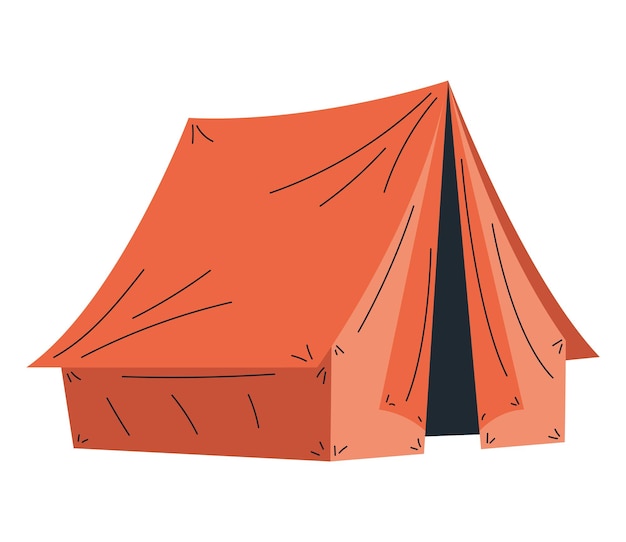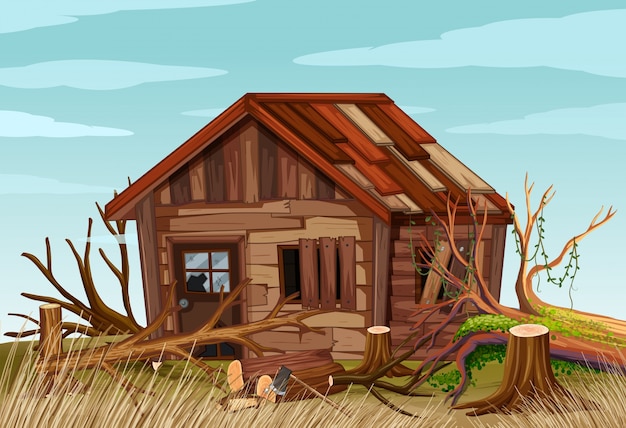Imagine you’re out on an adventurous hike, a camping trip, or even caught in an unexpected survival situation. Suddenly, the weather changes—rain starts pouring, temperatures drop, or strong winds pick up. Knowing to build a shelter can mean the difference between safety and danger.
Shelter is the priority in survival, even before food and water. It protects you from harsh weather, keeps you warm, and can deter wild animals. Whether you’re a seasoned survivalist, a casual camper, or someone who loves exploring the great outdoors, knowing how to construct a reliable shelter is a skill worth having.
In this guide, we’ll cover everything you need to know how to build a shelter in the wild, including essential techniques and different types of shelters suited to various environments. Let’s get started!
The Vital Role of Shelter in Any Emergency
In any survival scenario, securing shelter should be your immediate focus. The “Rule of Threes” clearly illustrates why: while you can survive days without food and water, exposure to harsh environmental conditions can become life-threatening within hours.
Extreme cold can lead to hypothermia, where the body loses heat faster than it can produce, causing organ failure. Conversely, extreme heat can result in heatstroke, where the body overheats and vital functions begin to shut down. Shelter acts as a crucial barrier against these dangers, helping to regulate body temperature and prevent fatal conditions.
Beyond temperature control, a shelter protects from wind, rain, and wildlife. It offers a sense of security, reduces stress, and allows you to conserve energy for other survival tasks like finding food and water. Natural shelters like caves or thick foliage can be lifesaving in the wild, but constructing a simple lean-to or debris hut can make all the difference
While water and food are essential for long-term survival, securing proper shelter ensures you live long enough to seek them. Prioritizing shelter can mean the difference between life and death in a survival situation.
Types of Survival Shelters in the Wilderness: What Works and What Doesn’t?
Various types of survival shelters can be built depending on the environment and the materials available. Each type serves a specific purpose, offering protection from the elements while ensuring a safe resting place.
1. Lean-To Shelter


A Lean-To Shelter is one of the simplest and fastest shelters to construct, making it ideal for mild weather when quick protection is needed. To build a lean-to, find a sturdy tree or log and place a long branch against it at an angle. Smaller branches and sticks should be leaned against the long branch to create a sloped wall. Cover the structure with leaves, grass, or moss for better insulation. This type of shelter provides basic protection from wind and rain but may not be suitable for extreme conditions.
2. A-Frame Shelter


An A-Frame Shelter is more effective in cold weather and offers better wind protection than a lean-to. It provides full coverage and helps retain body heat. To construct an A-frame, find two strong branches and position them to form an “A” shape. Place a long branch over the top to serve as a ridgepole. Then, lean sticks along both sides to form walls. Cover the walls with foliage, debris, or any available natural materials to insulate the shelter. This structure helps trap heat and offers a secure refuge in harsh conditions.
3. Debris Hut


A Debris Hut is a highly insulated shelter best suited for cold environments where warmth is a priority. If you are in a survival situation without a sleeping bag, this shelter can help retain body heat effectively. Begin by placing a long branch at an angle between two stable points, then lay sticks along the sides to form walls. The key to insulation is piling leaves, grass, and moss on top of the structure, creating a thick layer to trap heat. Once completed, crawling inside and using additional debris as a blanket can enhance warmth and protection.
4. Snow Cave (For Winter Survival)


A Snow Cave is the best option for those facing snowy conditions and extreme cold. This shelter takes advantage of the insulating properties of snow. To construct a snow cave, find a deep snowdrift or pack snow into a mound. Dig an entrance and a small tunnel leading inside, then hollow out the interior while ensuring thick walls remain for insulation. A small vent hole is essential to allow fresh air circulation and prevent suffocation. A snow cave can provide excellent warmth and protection in harsh winter conditions but requires careful construction to avoid collapse.
5. Tarp or Emergency Blanket Shelter


A Tarp or Emergency Blanket Shelter is the most effective solution if minimal effort and a quick setup are needed. This type of shelter is ideal when a tarp or emergency blanket is available. To set it up, tie a rope between two trees and drape the tarp over it. Secure the sides with rocks or sticks to keep them stable against wind. Adjusting the positioning can help maximize wind protection and warmth. While not as durable as natural shelters, this method offers rapid protection and is a great option for emergencies.
Why This Matters to You?
Shelter-building skills are not just for hardcore survivalists—they are valuable for anyone who spends time outdoors. Whether hiking, camping, or exploring remote areas, unexpected situations can arise, making shelter a critical survival tool.
- Hikers & Campers: A sudden storm, an injury, or getting lost can turn a simple outing into an emergency. Knowing how to build a shelter can protect you from harsh weather and keep you safe until help arrives.
- Adventurers & Explorers: Those venturing into remote regions must be prepared for unpredictable conditions. From extreme temperatures to wildlife encounters, a proper shelter can mean the difference between life and death.
- Preppers & Survivalists: Emergency preparedness includes shelter-building skills. Whether facing natural disasters, power outages, or unexpected crises, having a safe place to stay can be essential for survival.
- Hunters & Fishermen: Long expeditions in the wilderness may require overnight stays. A reliable shelter ensures comfort and protection from the elements.
- Anyone Who Enjoys the Outdoors: Accidents happen. Whether a day trip or a weekend adventure, knowing how to build a shelter is a fundamental skill that could save your life. Being prepared is always the smartest move.
Choosing the Ideal Shelter Location for Different Climates
Selecting the right location is a critical first step before building a shelter. A well-chosen site can protect you from harsh weather, wildlife, and environmental hazards, while a poor location can put your survival at risk. Taking the time to assess your surroundings will ensure your shelter is both safe and effective. Here are the key factors to consider:
1. Prioritize Safety
Your shelter’s location should minimize potential dangers. Always check for:
- Falling hazards – Avoid setting up under dead trees, loose rock formations, or unstable cliffs. Strong winds or even minor movements could send branches or rocks crashing down.
- Flood risks – Avoid low-lying areas near rivers or dry creek beds. Even if the weather seems calm, flash floods can occur suddenly due to distant rainfall.
- Wildlife activity – Look for signs like animal tracks, nests, dens, or droppings. Setting up in an active wildlife corridor increases the risk of encounters with territorial animals.
2. Access to Natural Resources
A good shelter location provides easy access to essential materials:
- Building materials – Choose an area where you can find sturdy branches, leaves, and rocks for constructing your shelter. You’ll expend valuable energy if you travel long distances to gather these materials.
- Water sources – While you want to avoid being too close to a river due to flooding risks, being within a reasonable distance from a clean water source is ideal for hydration and cooking.
3. Protection from the Elements
Your shelter should shield you from extreme weather conditions:
- Natural windbreaks – Hills, dense tree cover, or rock formations can block harsh winds, keeping your shelter stable and warmer.
- Avoid open areas – Exposure to strong winds, heavy rain, or direct sunlight can make survival more difficult. Instead, find a spot that offers some natural coverage.
- Consider sun exposure – If you’re in a cold environment, facing your shelter east can provide early morning sunlight, warming your space naturally. Opting for a shaded area in hot climates can help keep temperatures manageable.
4. Terrain Considerations
- Flat, dry ground – Avoid steep slopes or uneven ground, as these can make sleeping uncomfortable and increase the risk of water pooling during rain.
- Drainage – Ensure your site allows water to flow away from your shelter rather than collecting inside.
- By carefully selecting your shelter location, you improve your chances of staying safe, conserving energy, and building a structure that will save you from the elements. Finding the best spot can make all the difference in a survival situation.
Must-Know Tips for Building a Survival Shelter
- Stay Dry: Wet conditions increase hypothermia. Build a waterproof roof and avoid damp ground.
- Insulation is Key: Use leaves, grass, and moss to trap heat inside.
- Size Matters: A smaller shelter retains heat better. Could you not make it too big unless necessary?
- Fire Safety: Keep your fire at a safe distance to prevent accidental burns or shelter damage.
- Test Before Sleeping: Ensure your shelter is stable and won’t collapse during the night.
You’ve Built Your Shelter—Here’s What Comes Next
Building a shelter is a crucial survival step, but your work doesn’t stop there. Once your shelter is set up, shift your focus to other essential survival tasks to improve your chances of staying safe and comfortable and increasing the likelihood of rescue.
1. Build and Maintain a Fire
Fire is a valuable survival tool. It provides warmth, protection from predators, a means to purify water, and the ability to cook food. Here’s what to do:
- Gather dry wood, leaves, and tinder to start and sustain a fire.
- If available, use flint, matches, or a fire starter. If not, friction-based methods like the hand drill or bow drill can work.
- Keep your fire in a safe, well-ventilated spot near your shelter but not too close to avoid accidental fires.
- Maintain a steady supply of wood to ensure the fire stays lit, especially overnight.
2. Secure a Reliable Water Source
Staying hydrated is critical for survival. Dehydration can weaken you, impair judgment, and lead to serious health problems. Follow these steps:
- Locate a clean water source like a river, stream, or lake.
- Purify the water by boiling it for at least a minute, using purification tablets, or filtering it through cloth and charcoal if no other options are available.
- Collect rainwater using containers or improvised materials like large leaves.
3. Signal for Rescue
If you’re in a survival situation where rescue is possible, signalling should be a priority:
- Fire and Smoke: A large fire with green leaves or damp wood produces thick smoke that can be seen from a distance.
- Mirrors and Reflective Surfaces: If the sun is shining, use a mirror, polished metal, or smartphone screen to reflect light toward search teams or aircraft.
- Bright Clothing or Markers: Arrange brightly coloured clothing, rocks, or logs into a visible SOS signal on the ground.
- Sound Signals: Whistles, banging objects together, or shouting in intervals can alert rescuers. Three loud sounds in a row is a universal distress signal.
4. Improve and Insulate Your Shelter
Your shelter should be an evolving structure. Take time to:
- Reinforce walls with extra branches, leaves, or rocks for added insulation.
- Add bedding like dry leaves or pine needles to prevent direct contact with the cold ground.
- Adjust for ventilation to prevent condensation buildup inside.
5. Look for Food Sources
Once the essentials are safe and secured, consider finding food:
- Identify edible plants, nuts, and berries (only eat them if you are certain they’re safe).
- Look for insects, small fish, or traps you can set for a small game.
- Prioritize energy conservation—food is important, but water and shelter come first.
6. Maintain a Positive Mindset
Stay calm and focused, and take small steps toward improving your situation. Rest when needed, but keep working toward bettering your shelter, securing resources, and staying alert for rescue opportunities.
Following these steps after building your shelter increases your chances of survival and successful rescue.
Wrapping It Up
Knowing how to build a shelter in the wild is a fundamental survival skill that can mean the difference between life and death. Whether you find yourself lost, stranded, or facing extreme weather conditions, the ability to construct a reliable shelter provides protection, warmth, and peace of mind.
Different situations call for different types of shelters, from a simple lean-to for temporary cover to a well-insulated debris hut for long-term survival. The key to effective shelter-building is understanding your environment, selecting the right location, and using available materials wisely. However, survival skills are only valuable if practiced. Waiting until an emergency to figure out how to build a shelter can be dangerous.
Survival is about preparation, adaptability, and staying calm under pressure. Mastering shelter-building techniques takes an important step toward self-reliance in the great outdoors.

